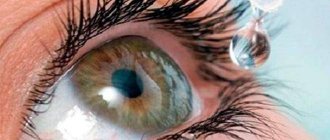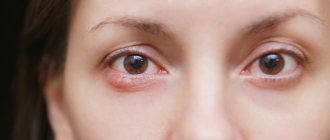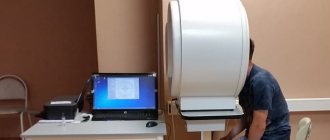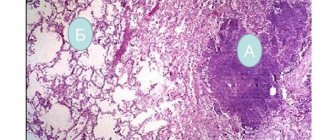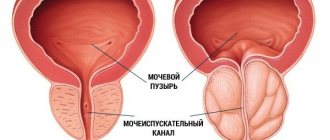Author:
Mironova Irina Sergeevna 5/5 (1 rating)
Honey. portal:
Prices Causes Symptoms Video of surgery Treatment Why choose us
Chalazion is a common eye disease or chronic inflammation caused by a blockage in the fatty (meibomian) gland of the eyelid. The name chalazion is translated from Greek as a nodule or hailstone. Indeed, in a patient with a chalazion, a small, round, dense formation can be felt in the area of the upper or lower eyelid. The disease is more often detected in patients aged 20 - 50 years, children get sick less often.
Causes
Meibomian glands are located in the thickness of the upper and lower eyelids, their excretory ducts open at the eyelash line, near the posterior edge of the eyelids. Normally, the glands secrete a fatty secretion that moisturizes and lubricates the edges of the eyelids, reducing friction on the surface of the cornea. The triggering point for the formation of a chalazion is a blockage of the meibomian gland duct. The cause of blockage may be infection (due to dysbacteriosis, weakened immunity), dirty hands, violation of the rules of wearing contact lenses, increased oily skin. In some cases, a chalazion forms secondarily, at the site of an acute inflammation of the eyelid that has not been fully treated (stye).
Other causes of blockage of the meibomian glands include:
- anatomical features of the meibomian gland ducts (too narrow, tortuous);
- thickening of the secretion of the gland, as a result of which its removal becomes difficult;
- diseases of the endocrine system and metabolic disorders (diabetes mellitus, obesity, etc.);
- frequent or chronic inflammatory eye diseases (conjunctivitis, blepharitis, etc.);
- cicatricial changes in the tissues of the eyelids, for example, with frequent or multiple styes;
- dermatological diseases accompanied by a violation of the cell division cycle, excessive or insufficient activity of the sebaceous glands (rosacea, seborrheic dermatitis, etc.);
- chronic diseases of the digestive system.
When a chalazion forms, there is often a combination of several factors. For example, using a large amount of decorative cosmetics or wearing false eyelashes together with metabolic disorders or disorders of the immune system.
In situations where blockage of the meibomian gland is observed in a chronic course, it is important to establish the causes and prerequisites and eliminate them.
Pathogenesis
The disease occurs against the background of blockage of the sebaceous gland of the eyelid and its chronic inflammation. A proliferative type of chronic inflammation occurs. Blockage of the excretory duct occurs against the background of colds, inflammation of the edge of the eyelids ( blepharitis ) or inflammation of the gland itself ( meibomitis ). Often the cause of blocked ducts is diseases of the gastrointestinal tract. Lipid secretion, having no outflow, accumulates in the gland duct. The tissue around the gland becomes inflamed, and the lesion becomes encapsulated over time. This is manifested by the formation of a benign seal in the form of a nodule on the eyelid.
Symptoms
The blocked meibomian gland increases in size and is surrounded by a dense capsule.
At the initial stage of development of the disease, such compaction is externally invisible and can only be felt (when washing off makeup, touching the eyelids, etc.).
But as the secretion accumulates more and more in the capsule, the formation increases in size and becomes more noticeable.
Along with this, itching in the eye, watery eyes, and a general feeling of discomfort may appear, depending on what part of the eyelid the chalazion is located. Severe swelling and redness of the eyelid in the case of an uncomplicated course of the disease is usually absent, vision is not impaired. The quality of vision may suffer in cases where the chalazion reaches large sizes (sometimes up to 1 cm in diameter) and because of this “blocks” part of the field of vision, causing severe discomfort when blinking.
With prolonged absence of treatment, growth of the tumor is not the only threat. The lack of secretion outflow from the gland becomes a predisposing factor for infectious complications. When a secondary infection occurs, symptoms of inflammation come to the fore: redness of the mucous membrane of the eyelid, swelling of the eyelid and hyperemia of the skin in the chalazion area, pain.
In some cases, the chalazion opens spontaneously, but in most cases the disease is chronic. In this case, the patient needs to be examined by a specialist and prescribed adequate treatment.
Particular attention should be paid to patients over the age of 40 who have discovered a similar formation on their eyelid. You should not put off going to the doctor, despite the fact that the disease does not disrupt your usual way of life. In older people, in rare cases, a meibomian gland tumor is detected, including a malignant one, the symptoms of which in the early stages do not differ in any way from the symptoms of a chalazion.
Classification
According to localization, chalazion can be:
- upper eyelid;
- lower eyelid;
- both eyelids.
By number of formations:
- single chalazion;
- multiple chalazions.
Abscess chalazion - pyogenic granuloma with purulent contents - should be included in a separate category. It develops due to the addition of an infection. The seal on the eyelid increases, becomes painful when touched, the skin in its area turns red, and the surrounding tissues swell.
When a chalazion on the eye is localized closer to the outer edge of the eyelid, a nodule under the skin is immediately observed. If the blocked duct emerges closer to the cartilaginous plate of the conjunctiva, an internal chalazion is formed, which can be seen by everting the eyelid. In this case, a slight redness with a grayish lesion in the middle is visible on the mucous membrane.
Diagnostics
Before prescribing treatment, the doctor interviews the patient, collects anamnesis, and conducts an examination. To confirm the diagnosis, an external examination is often sufficient, which consists of everting the eyelid and assessing all the parameters of the neoplasm (redness and swelling, whether or not extending beyond the chalazion, the absence or presence of signs of an infectious process, etc.).
In cases where the doctor has doubts about the nature of the disease, a histological examination is performed. It allows you to exclude or confirm the malignant nature of the neoplasm. During the diagnosis, the characteristics of the course of the chalazion are also determined, which plays a role in prescribing treatment.
Physiotherapy
Physiotherapeutic procedures include heating with compresses, treatment with current (UHF) and ultrasound, laser therapy, massage, and magnetic therapy.
The listed manipulations promote rapid relief from the inflammatory process and healing of affected tissues. The UHF procedure is aimed at resolving a dense lump that has formed on the eyelid. A high-frequency electric field is applied, which affects cellular structures. However, UHF cannot be used in case of a purulent process; the procedure is prescribed only when a dense lump appears on the eyelid and redness.
An effective method of influencing affected tissue is electrophoresis, which uses a combination of drugs with an electric field.
Phonophoresis involves the use of drugs with ultrasonic influence. With this method of treatment, the drug penetrates only the affected tissue areas, without touching healthy cells.
Magnetotherapy uses a low-frequency magnetic field to influence tissue.
Types of chalazion
Blockage of the meibomian gland ducts can be chronic and abscessive.
Chronic chalazion . The formation of a chalazion occurs over a long period of time and gradually. There are no periods of exacerbation, no signs of inflammation.
Abscess chalazion . This course of the disease is observed when an infectious agent penetrates the capsule. At the same time, the clinical manifestations of chalazion become more pronounced. The patient complains of pain in the area of the tumor or the entire eyelid, swelling, itching, pain in the eyes.
Chalazion treatment
Self-treatment of chalazion at home before a doctor examines the affected eye and makes a final diagnosis is not recommended. It is forbidden to try to squeeze or pierce the chalazion yourself; this can have very serious negative consequences.
Depending on the duration of the disease and the characteristics of the process, conservative or surgical treatment methods are used.
Drug treatment is effective only at the very beginning of the disease, and delaying contacting a doctor is a way to wait until the need for surgical treatment of chalazion.
Fresh, uncomplicated chalazion responds quite well to conservative treatment with anti-inflammatory eye drops and ointments (hydrocortisone, 1% yellow mercury). In the absence of symptoms of inflammation, the doctor may additionally prescribe dry heat (UHF) and eyelid massage. In the event of a secondary infection, any thermal procedures (compresses, warming) are contraindicated, because this contributes to the spread of inflammation to adjacent tissues with the subsequent development of limited (abscess) or diffuse (phlegmon) inflammation of the eyelid.
Another effective method of treating chalazion is injection of anti-inflammatory drugs into its cavity (Kenalog, Diprospan, etc.). The drug selected by the doctor is injected directly into the chalazion cavity, this promotes the gradual resorption of the pathological formation over 1-2 weeks.
Along with drug and physiotherapeutic treatment, it is important that the patient strictly observes the rules of personal hygiene and eliminates factors that contribute to re-occlusion of the meibomian gland (long-term wearing of unsuitable contact lenses, use of decorative cosmetics, etc.).
It is important to understand that self-medication is unacceptable, since the visual organs are very vulnerable to any intervention. And attempts to get rid of a chalazion on your own can lead to eye injury, decreased visual acuity and other serious consequences.
List of drugs
Chalazion can become a chronic process, so treatment should not be delayed under any circumstances. The following ointments and liniments help to avoid negative consequences:
Levomekol
Compound:
- chloramphenicol;
- methyluracil;
- polyethylene oxide
Properties: suppresses bacteriological flora, eliminates swelling.
Price: 70 rubles (3g).
The drug is considered a broad-spectrum antibiotic. It is used as a compress (Levomekol is applied to a piece of film and applied to the tumor) or rubbed. In the case where the hailstone is located on the lower eyelid, the ointment is placed under the eyelid.
Blefarogel
Compound:
- hyaluronic acid;
- aloe juice;
- propylene glycol;
- glycerol;
- methylparaben;
- carbomer;
- hemodesis;
- purified water.
Properties: has an antihistamine effect, kills microbes, accelerates the resorption of gland blockage. Effective for the prevention of chalazion.
Price: 189 rubles (15 ml).
Apply the product to the affected eyelid with gentle massaging movements.
Phloxal
Compound:
- oflocacin;
- benzalkonium chloride;
- hydrochloric acid solution.
Properties: destroys bacteria, preventing their reproduction. Relieves associated symptoms.
Price: 290 rubles (3g).
Used both outside and inside the eyelid. Strips of ointment 1.5 cm long are placed under the eyelid overnight. During the day, the drug is applied directly to the affected area.
Vishnevsky ointment
Compound:
- Castor oil;
- tar;
- fish fat;
- xeroform.
Properties: eliminates the symptoms of the disease at an early stage of development. Disinfects the source of inflammation. Thanks to the ointment, the chalazion quickly matures and bursts, the purulent contents flow out, leaving a clean sebaceous duct.
Price: 25 rubles (20g).
The product is applied in a small amount directly to the eyelid, after which it is rubbed in with light movements. The problem area is treated up to 5 times per day.
Baneocin
Compound:
- bacitracin zinc;
- neomycin sulfate;
- magnesium oxide.
Properties: used to treat bacterial infections of the skin and mucous membranes. It is a broad-spectrum antibiotic.
Price: 110 rubles (5g).
Liniment is used for 7 days twice a day. Combining the drug with other antibiotics is prohibited.
Tetracycline
Compound:
- tetracycline;
- lanolin;
- mineral oil.
Properties: destroys most pathogenic microorganisms, reduces inflammation. Suppresses the synthesis of bacterial proteins.
Price: 300 rubles (3g).
Apply to the affected area using a compress. A piece of sterile bandage or cotton pad is placed on top. The course of use of the drug in advanced cases lasts up to 2 weeks.
Hydrocortisone
Compound:
- hydrocortisone acetate;
- stearic acids;
- sorbitol;
- water;
- benzyl alcohol.
Properties: prevents stagnation of lymphatic fluid. Accelerates the attenuation of the inflammatory process, relieves swelling, reduces itching. At first the pea stops growing, but after a few days it completely dissolves.
Price: 150 rubles (3g).
To treat hailstones, make a compress: moisten a clean cloth in hot water and apply it to the affected area for 5 minutes. The temperature should be quite tolerable to avoid burns. Then the eyelid is lubricated with ointment, not only the chalazion itself, but also the skin around it.
Ichthyol
Compound:
- tar;
- ichthyol;
- resin;
- sulfur.
Properties: has an antiseptic effect, warms the skin, helps soften the capsule, relieves discomfort.
Price: 40 rubles (30g).
Apply directly to hailstones two to three times a day. You can apply a compress at night.
Collargol
Compound:
- colloidal silver;
- protein albumin;
Properties: is a good antiseptic. Relieves swelling, has a calming effect, destroys pyogenic bacteria, and stops the inflammatory process.
Price: 130 rubles (3g).
The product should be rubbed into the skin of the eyelid 4 times a day. The course of therapy takes no more than 7–10 days.
Removal operation
Neoplasms 5 mm in size, long-existing or prone to recurrence must be removed surgically. The operation is usually performed on an outpatient basis, under local anesthesia, and its duration does not exceed 20–30 minutes. The doctor grabs the area of the eyelid with the chalazion using a fenestrated clamp, then opens the neoplasm and removes it along with the capsule. If there is a fistula tract, it is opened and excised along its entire length. After several stitches are placed, a pressure bandage is applied to the area of the operated eye. For a week after surgery, you will need to instill anti-inflammatory drops or apply ointment.
Sources
- Grishina E.E. Inflammatory diseases of the eyelids from the perspective of an ophthalmo-oncologist // Breast Cancer. Clinical ophthalmology. - 2021. - No. 3. - P. 190-193.
- Korelina V.E. Red eye syndrome // Russian family doctor. - 2021. - T. 24. No. 1. - P. 5–13.
- Machekhin V.A. Clinical and histological analysis of tumors of the eye and its protective and auxiliary apparatus // Practical Medicine. - 2012. - No. 4. - P. 255-259.
- Ophthalmology. National leadership / ed. S.E. Avetisova, E.A. Egorova, L.K. Moshetova and others - M.: GEOTAR-Media, 2018. - 904 p.
- Polunina E.G., Alieva A.E. Modern possibilities of treating meibomian gland dysfunction: practical recommendations // Clinical ophthalmology. - 2013. - Volume 13, No. 1. - P. 31-32.
- Guide to Clinical Ophthalmology / ed. A.F. Brovkina, Yu.S. Astakhova. – M.: MIA, 2014. – 955 p.
- Trubilin V.N., Polunina E.G. and others. Algorithm for the treatment of meibomyitis, barley and chalazion // Ophthalmology. - 2021. - No. 16(4). — P. 515-521.
- Trubilin V.N., Polunina E.G. and others. Algorithm for therapeutic hygiene of the eyelids for pathology of the ocular surface. - M.: FMBA, 2021. - 32 p.
Laser chalazion removal
Chalazion removal surgery can also be performed using a medical laser. This method has its advantages:
- Less traumatic intervention. A surgical laser provides high precision tumor removal without affecting healthy tissue.
- Higher safety profile. This is also due to the high-precision impact on the chalazion: the risks of damage to the tissues surrounding the formation are eliminated.
- Reducing the risk of complications. When the laser comes into contact with tissue, immediate coagulation of blood vessels occurs, which avoids bleeding during or after surgery. And exposure to high temperatures, although it occurs within a fraction of a second as part of a single action by the surgeon, ensures tissue disinfection and eliminates the possibility of infection.
The choice of a specific method of surgical removal, necessary and appropriate in a particular case, remains with the attending physician.
Complications
Rupture of the chalazion into the thickness of the cartilage causes the development of granulation tissue and the formation of pyogenic granuloma. A breakthrough of contents onto the inner and outer surface of the eyelid may be accompanied by the formation of a fistula. In some cases, the pressure of a hailstone on the eyeball causes significant refractive errors - myopia, astigmatism.
The progressive growth of the chalazion can lead to disfigurement of the eyelids: fibrosis of the cartilage with subsequent turning of the eyelid inward, the appearance of uneven edges and baldness of the eyelid.
Indications for surgical removal of chalazion
Chalazion removal is indicated under the following circumstances:
- Conservative treatment was ineffective.
- the effect of conservative treatment is short-term.
- The size of the chalazion exceeds 5 mm in diameter.
- any complications (impaired vision quality, infection, etc.).
- frequent relapses of chalazion.
This list of indications for surgical removal of a chalazion can be expanded at the discretion of the attending physician.
Advantages of treatment of chalazion in MGK
Our doctors are ready to provide the necessary medical and diagnostic assistance every day, seven days a week, from 9 am to 9 pm. Attentive attitude, high-quality diagnostics using the best examples of modern technology, as well as the vast practical experience of our specialists are a guarantee of high treatment results even in the most complex cases. After the diagnosis, our specialists will explain the results in clear language and, if necessary, recommend possible treatment methods.
All medical procedures are carried out using sterile instruments in specially equipped operating rooms, in compliance with the rules of asepsis and antisepsis, which eliminates the possibility of infection.
Chalazion removal occurs on an outpatient basis, usually under local anesthesia. According to indications (childhood, low stress resistance), other methods of pain relief can be used. All removed tumors must undergo histological examination to exclude the possibility of a malignant tumor. We take responsibility for the results of treatment, so our specialists ensure regular examination of the patient after surgery until his full recovery. Our doctors will also recommend the best ways to strengthen your immune system to prevent recurrence of the disease.
Survey
Diagnostics is carried out by an ophthalmologist. He conducts a survey of the patient - collecting complaints and medical history, finding out how long the patient has been bothered by the symptoms, what concomitant diseases there are. Then the specialist performs an external examination of the skin around the eyes, eyelids, mucous membranes, and biomicroscopy of these structures under magnification.
For recurrent, multiple chalazions, the patient may be advised to consult other doctors, as well as laboratory tests, for example, blood tests for cholesterol, glucose, etc.
Histological examination is carried out after surgical removal of the chalazion in order to exclude adenocarcinoma of the meibomian gland.
Prevention of chalazion development
Since the development of chalazion is closely related to the level of personal hygiene, it is important to adhere to the following rules:
- Avoid eye contact with other people's personal items (towels, cosmetics, etc.);
- Rinse off decorative cosmetics thoroughly using special delicate products.
- Monitor the length of time you wear contact lenses and remove them on time.
- Carry out regular and proper antiseptic treatment of contact lenses.
- Train yourself not to touch your eyes unless absolutely necessary, and do this only after thoroughly washing your hands.
In addition, it is important to monitor your general health, since many diseases of internal organs and skin can provoke the development of chalazion.
Expert opinion
Experts in the field of ophthalmology are inclined to believe that the level of personal hygiene plays a decisive role in the formation of a chalazion. This means that, other things being equal, the disease is more likely to develop in those who neglect hygiene requirements.
Therefore, it is important to keep your facial skin clean, use specialized products when washing your face, accustom yourself to regularly wash your hands, and refuse to use other people’s personal items (cosmetics, towels, etc.)
FAQ
Chalazion is a fairly common disease. In this regard, patients often have the following questions:
Are styes and chalazions the same thing? No. Barley is an inflammation of the hair follicle (eyelash), and a chalazion develops in the thickness of the eyelid itself. In addition, barley has an acute course - it ripens within 3-4 days, after which it often opens spontaneously, releasing purulent contents. Chalazion progresses slowly, and suppuration is observed very rarely.
Can a stye turn into a chalazion? No, he can not. But the frequent appearance of styes may indicate health problems, which themselves can provoke blockage of the meibomian gland. In addition, frequent styes can cause microscopic scar changes in the tissues of the eyelids, and this becomes a prerequisite for blockage of the meibomian gland ducts.
Is the tendency to form chalazions inherited? No hereditary link has been identified, but some diseases of the endocrine system or other diseases that increase the likelihood of developing a chalazion can be passed on from parents to children. Familial cases of chalazion, which affects all or many members of the family, are more likely to be associated with hygiene habits (for example, lack of habit of washing hands before washing the face) rather than with genetic factors.
Can a new chalazion form in place of the removed one? This doesn't happen often, but it's still a possibility. To minimize such situations, it is important to identify the cause of chalazion formation, since many of them can be eliminated (for example, nutritional disorders, untreated diseases of the gastrointestinal tract, etc.).
Who is more likely to get chalazion? For those who are in one way or another predisposed to blockage of the meibomian gland ducts (anatomical features of the structure of the ducts, frequent inflammatory or infectious eye diseases, neglect of hygiene rules, etc.).
What to do if a chalazion appears? Contact your doctor. Although chalazion does not pose an immediate threat to health and life, it can cause infectious complications. In addition, in older people, a malignant neoplasm can be “masked” as a chalazion.
All questions you are interested in can be asked by phone (calls from mobile phones and regions of the Russian Federation are free) and by phone in Moscow or online using the appropriate form on the website.
How does the disease progress?
The pathological process and the increase in size of the chalazion occurs gradually - over 3-7 days. Then the problem becomes chronic - the tumor does not increase, but does not decrease either. Sometimes the chalazion resolves on its own within 5-8 weeks. However, in most cases this does not happen. The tumor may not cause obvious discomfort to the patient, but the aesthetic defect in the eye is clearly visible4.
The worst thing is when the contents of the chalazion rupture. It mainly breaks out from the inside of the eyelid - the tissue there is thinner. A breakthrough is typical for clinical cases when blockage of the gland is accompanied by an infectious process. Then purulent contents are added to the sebaceous contents of the tumor. In these cases, chalazion is as similar as possible to barley (see Table 1 for how to distinguish one disease from another). A breakthrough of the tumor contents, especially with pus, is dangerous for infection of the eye tissues, because the eyelid is in direct contact with the conjunctiva.
